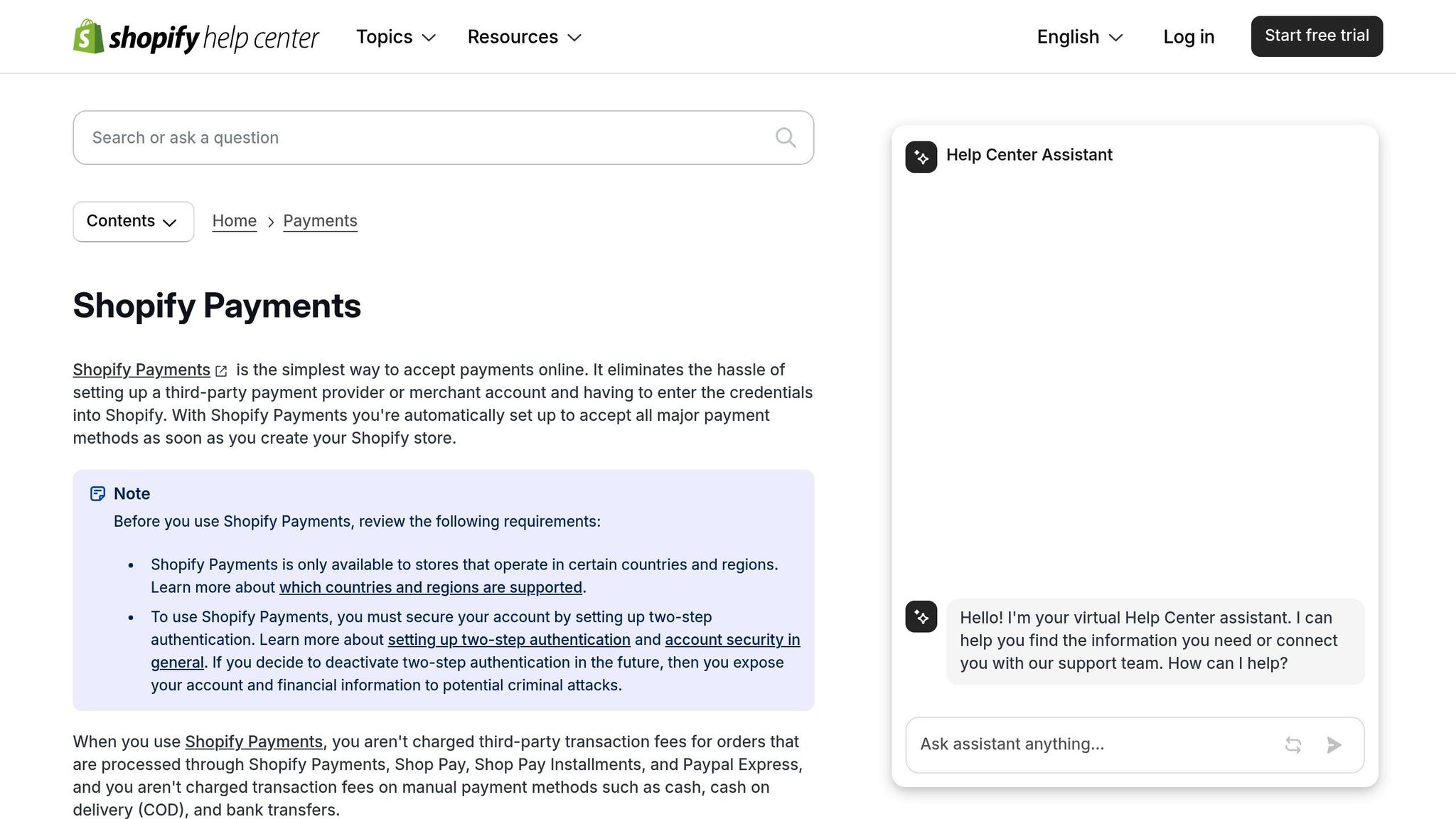
Want to lower your Shopify store's running costs? Here are 5 practical ways to save money while keeping your store efficient and competitive:
- Review App Costs: Audit your Shopify apps, remove unused ones, and switch to multi-purpose apps to reduce monthly expenses.
- Cut Shipping Costs: Use Shopify Shipping for discounted rates, optimise packaging sizes, and offer store pickup to save on delivery fees.
- Automate Tasks: Use tools like Shopify Flow to streamline order management, marketing, and inventory updates, saving time and reducing errors.
- Lower Payment Fees: Use Shopify Payments to avoid third-party fees and negotiate better rates if you process high transaction volumes.
- Reduce Power Costs: Switch to energy-efficient equipment, monitor power use with smart meters, and encourage staff to save energy.
By focusing on these areas, you can cut costs, improve efficiency, and stay profitable in New Zealand's competitive retail market.
| Strategy | Savings Potential | Complexity |
|---|---|---|
| App Cost Review | Reduced software costs | Low |
| Shipping Optimisation | Lowered shipping expenses | Medium |
| Time-saving Tools | Decreased labour costs | Medium |
| Payment Fee Reduction | Savings on payment processing fees | Low |
| Power Cost Management | Cut down on energy bills | Low |
These steps can help Kiwi Shopify store owners stay ahead, even in a challenging economic environment.
How To Lower the Cost of Shopify's Payment Processing?

Review and Cut App Costs
Many Shopify store owners unknowingly pay for apps they barely use. Taking the time to review and optimise your apps can help cut monthly costs without compromising your store's functionality.
Check Your Apps
Start by reviewing all the apps listed in your Shopify admin panel. As speedboostr points out, "The majority of Shopify stores have old unused app code slowing their site down" [1]. This leftover code not only increases costs but can also slow down your store's performance.
Look for active subscriptions, monitor how often each app is used, spot duplicate functionalities, and check your theme files for any leftover code from uninstalled apps.
Consider Multi-Purpose Apps
Instead of relying on several single-function apps, switch to apps that handle multiple tasks. For instance, Roadmap offers features like:
- Campaign creation
- Loyalty programme management
- Gift-with-purchase (GWP) and discount tools
- Bundle setup
- Tag organisation
Using one app for multiple needs can simplify your workflow and reduce your monthly app expenses.
Lower App Costs
Unused or poorly optimised apps can also affect your store's speed and costs. For example, speedboostr explains that "if a product upsell app allows customers to add Product B to the cart when viewing Product A, it should only load on the product page. Loading the app's code on every page via theme.liquid unnecessarily impacts load speed on your home page, collections, and cart pages" [1].
Here are some tips to cut app-related costs:
- Audit your spending: Look into your app subscriptions and negotiate for better rates on long-term plans.
- Optimise app loading: Ensure apps only load on the pages where they're needed.
- Remove unused code: Check theme files like
theme.liquid,product.liquid, andcart.liquidfor any leftover app code [1].
Before removing any code, preview your theme to confirm everything works as expected. This step ensures you maintain your store's performance while cutting unnecessary expenses.
Up next, find out how to reduce shipping costs while improving your store's efficiency.
Cut Shipping Costs
Shipping costs can eat into your profits. But with a few smart tweaks, you can lower these expenses while still ensuring reliable deliveries for your customers.
Use Shopify's Shipping Rates
Shopify Shipping offers discounts based on your plan, which can significantly reduce your shipping expenses - especially for international orders.
Here’s a breakdown of potential savings with Shopify Shipping:
| Shipping Type | Basic Plan | Shopify Plan | Advanced Plan |
|---|---|---|---|
| Domestic | Up to 35% | Up to 38% | Up to 43% |
| To US | Up to 44% | Up to 47% | - |
| International | Up to 58% | Up to 60% | Up to 64% |
To get the most out of these discounts, use Shopify's shipping calculator with accurate package details like weight and dimensions. Adjust your packaging to further cut costs.
Reduce Package Sizes
The size of your package directly impacts shipping costs. Smaller packages mean lower fees. As Shopify advises, "Don't ship air! Always aim for the smallest possible package dimensions" [2].
Here are some practical ways to minimise package size:
- Use poly mailers or padded envelopes when possible
- Opt for lightweight corrugated boxes
- Choose packing materials that don’t add unnecessary weight
- Get a postage scale to weigh items accurately
Review your order history to identify the best packaging options. For local customers, consider offering pickup to completely eliminate shipping fees.
Add Store Pickup
Store pickup is a great way to save on shipping while offering convenience to your customers. To set it up effectively:
- Define clear processing times
- Provide easy-to-follow pickup instructions
- Keep your inventory system updated
- Enable notifications to inform customers when their order is ready
For businesses with multiple locations, setting up store transfers can help keep products available at the right pickup point. This ensures customers can always collect their orders without delays.
Add Time-Saving Tools
Automation eliminates repetitive tasks and reduces errors. Here's how you can simplify processes, save time, and cut costs.
Speed Up Order Processing
Shopify Flow is a built-in tool that automates order management. It allows you to:
- Tag, sort, and flag orders based on value, location, or risk
- Create custom workflows without needing coding skills
"Flow is incredible and a must-have to extract maximum value from your Shopify subscription. The amount of 3rd party services and subscriptions you can avoid by dedicating your time to Flow is, quite frankly, unbelievable." - IppodoTea.com [3]
For additional automation, check out Almond Labs' Roadmap toolkit to handle campaigns and daily operations.
Set Up Auto-Marketing
Automation can handle many marketing tasks, saving time and reducing costs. Here are a few examples:
| Marketing Task | Automation Benefit | Cost-Saving Impact |
|---|---|---|
| Welcome Emails | Immediate response to new customers | Cuts down on customer service workload |
| Loyalty Points | Automatic reward calculations | Removes the need for manual tracking |
| Stock Alerts | Instant notifications | Prevents missed sales opportunities |
You can also automate actions like abandoned cart reminders and loyalty updates. This ensures ongoing customer engagement without adding extra staff.
Link Stock Updates
syncX: Stock Sync (rated 4.6/5 from 1,358 reviews) offers a reliable inventory management solution starting at just NZ$8 per month.
"Have been using Stocksync for 3+ years now and it has worked consistently and reliably... The support staff have been top notch, knowledgeable, and dedicated, which has been most important for us." - Adult Stuff Warehouse [4]
Key features include:
- Real-time inventory syncing across all sales channels
- Automated stock updates to keep inventory accurate
- Low stock alerts to avoid running out of products
- Integration options using APIs or CSV files to fit into your existing systems
These tools can help you maintain smooth operations and focus on growing your business.
sbb-itb-f46a14b
Lower Payment Fees
Cutting payment fees is another way to reduce operating costs, just like automating tasks or improving shipping processes.
Processing fees can eat into your profits, but there are ways to lower these costs while keeping payments running smoothly.
Use Shopify Payments

Shopify Payments makes it easy to accept major credit cards without any extra third-party fees [5].
- Integrated checkout removes the need for external payment providers
- Real-time payout tracking directly in your Shopify admin
- Simplified processing for major credit cards
Here's a quick comparison of payment methods with and without Shopify Payments:
| Payment Method | With Shopify Payments | Without Shopify Payments |
|---|---|---|
| Credit Cards | Standard rate only | Standard rate plus third-party fees |
| Local Payment Methods | No extra fees | Additional transaction fees |
| Payout Tracking | Real-time in admin | Varies by provider |
By integrating your payments effectively, you can set the stage for additional savings through smarter payment strategies.
Guide Payment Choices
Encourage customers to use lower-cost payment methods. Offer small discounts for bank transfers, highlight cost-effective options during checkout, and include popular local payment methods used in New Zealand. Building strong relationships with payment processors and reviewing transaction data regularly can also uncover ways to minimise fees.
Negotiate Better Payment Rates
If your store handles a high volume of transactions, you may be able to negotiate lower rates. Here's what can give you an edge:
- Monthly sales data to back your negotiations
- Understanding customer payment preferences to adjust fee structures
- Special rates for unique business models or high-value transactions
Taking a proactive approach to managing payment fees can lead to noticeable savings. Regularly reviewing your payment setup ensures you're always getting the best rates for your store.
Save on Power Costs
Power bills can take a big chunk out of your store's operating expenses, especially if you run a warehouse or retail space. Cutting back on energy use is a smart way to save.
Use Better Equipment
Switching to energy-efficient equipment can make a noticeable difference. For instance, LED lighting uses about 85% less energy than traditional incandescent bulbs and lasts up to 10–20 times longer [7].
Here’s how modern equipment can help:
| Equipment Type | Energy Savings | Additional Benefits |
|---|---|---|
| LED Lighting | 85% less energy [7] | Saves NZ$100–NZ$300 per bulb |
| Laptops vs. Desktops | 50% less energy [6] | |
| All-in-One Printers | 50% reduction [6] |
"LED lightbulbs use around 85% less energy and last longer than traditional incandescent bulbs - and they're safer for your home." - Gen Less [7]
Stop Using Paper
Once you’ve upgraded your equipment, consider going digital to save even more. Digital invoicing, cloud storage, and automated reporting can cut down on paper use and energy consumption.
If printing is unavoidable, set devices to print double-sided to minimise paper usage. All-in-one printers are a good choice - they use half the energy of separate devices for printing, scanning, and copying [6].
Monitor Power Use
After upgrading equipment and digitalising processes, keep an eye on your energy use to find new ways to save.
-
Install Smart Meters
Smart meters can track when and where power is being used the most, helping you identify peak usage times and areas where energy can be saved. -
Use Equipment Controls
Place servers and copiers in naturally ventilated areas to avoid extra cooling costs. Poor server placement can waste up to 40% of energy [6]. -
Engage Staff
"People in your office have direct control over half the energy it uses. Motivating staff to guard against energy waste can have a significant impact on your carbon footprint." - Gen Less [6]
Simple actions, like assigning someone to turn off shared equipment at the end of the day or installing motion sensors for lighting in low-traffic areas, can make a big difference. Regular HVAC maintenance and smart thermostats can also help keep energy use in check [8].
New Zealand Store Tips
Cut costs on your Shopify store by tailoring strategies specifically for the New Zealand market. These local tweaks can help you save money while improving your store's operations.
NZD Setup
Make sure your store displays prices in NZD and handles GST correctly. Here are some ways to format your currency display:
| Currency Display Option | Format Example | Best Use Case |
|---|---|---|
| Standard Format | NZ$149.99 | Default for most stores |
| With Currency Code | NZ$149.99 NZD | For international customers |
| Tax-Inclusive | NZ$149.99 (incl. GST) | For local customers in NZ |
To manage GST accurately, go to Settings > Taxes and duties > Tax regions in your Shopify dashboard.
NZ Shipping Options
If you're dispatching fewer than 50 items a week, consider using My NZ Post Business. It’s an affordable option with useful features:
| Feature | How It Helps |
|---|---|
| Online Quote System | Quickly compare shipping rates |
| Bulk Label Creation | Saves time for your team |
| Automated Tracking | Lowers customer service queries |
| Returns Management | Simplifies handling returns |
You can also offer local pickup, particularly in Auckland, to eliminate shipping costs. For rural areas, consolidating orders can reduce delivery trips and associated expenses.
NZ Power Rules
Follow New Zealand's energy-saving guidelines to lower your power bills.
-
Equipment Standards
Use appliances with an Energy Rating Label to minimise energy consumption. -
Digital Solutions
Switch to Shopify's digital invoicing to save on paper and printing costs.
Wrapping It Up
Cutting costs smartly can improve your store's performance without holding back growth. By focusing on the five areas we've covered, you can make your operations more efficient and effective.
Take the example of home furnishing retailer Lull. They saw big results after streamlining their operations:
"Implementing Shopify inspired us to review our org structure, software stack, and operating expenses", explains Mark Nagelmann, director of web operations at Lull. "This led to a 25% reduction in software costs and 10%–15% savings on internal tech expenses. Eliminating inefficiencies made our opex model leaner and more cost-effective." [9]
Here’s a quick overview of the strategies and their impact:
| Strategy | Savings Potential | Complexity |
|---|---|---|
| App Cost Review | Reduced software costs | Low |
| Shipping Optimisation | Lowered shipping expenses | Medium |
| Time-saving Tools | Decreased labour costs | Medium |
| Payment Fee Reduction | Savings on payment processing fees | Low |
| Power Cost Management | Cut down on energy bills | Low |
For Kiwi businesses, these targeted strategies are key to dealing with market pressures and ensuring long-term success. Tools like Almond Labs' Roadmap can further simplify and enhance these efforts by automating campaigns and improving operations. Pair these strategies with local insights, such as GST compliance and NZ Post Business integration, to drive profitability.
This approach not only trims costs but also strengthens your business for the challenges ahead. As Vincent Arrouet, CEO of Sunology, pointed out:
"WordPress incurs significant costs in terms of development and project management, which would have eventually exceeded the price of Shopify's package." [9]
Heading 1
Heading 2
Heading 3
Heading 4
Heading 5
Heading 6
Lorem ipsum dolor sit amet, consectetur adipiscing elit, sed do eiusmod tempor incididunt ut labore et dolore magna aliqua. Ut enim ad minim veniam, quis nostrud exercitation ullamco laboris nisi ut aliquip ex ea commodo consequat. Duis aute irure dolor in reprehenderit in voluptate velit esse cillum dolore eu fugiat nulla pariatur.
Block quote
Ordered list
- Item 1
- Item 2
- Item 3
Unordered list
- Item A
- Item B
- Item C
Bold text
Emphasis
Superscript
Subscript



